5 Ways E-Commerce Grocers Can Personalize the Customer Experience in 2022
Consumers demand personalization. But it’s becoming tougher to offer this experience with new laws and regulations prohibiting companies from collecting much-needed customer data.
You have the California Consumer Privacy Act, GDPR, and let’s not forget the iOS 14 update. These are a few of the many roadblocks standing between retailers and customer personalization efforts—but there’s hope.
Giving your customers the personalization they seek is still possible using an “old-fashioned” strategy mom-and-pop shops are renowned for:
Getting to know your customers.
Sure, data isn’t easy to come by these days, but that doesn’t mean it’s not there. Prioritizing relationship building with buyers is critical going forward, and the best way to achieve this is by using technology.
Let’s review how grocers can personalize the shopping experience across all channels using a grocery e-commerce platform.
First-party data is the holy grail for personalization in grocery
When COVID hit, online sales for food and beverages skyrocketed, and there’s no end in sight.
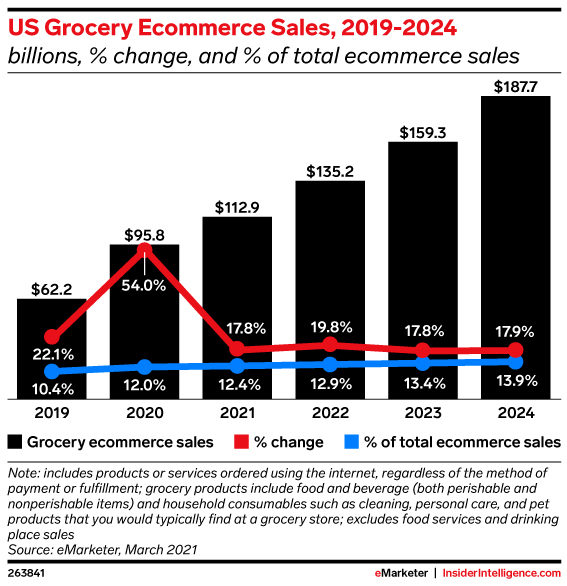
Source
But consumers are opting out of having their personal data collected. Plus, Apple, Firefox, and Brave are already blocking third-party cookies, with Chrome following suit in 2023. So what good is an e-commerce website if you can’t track what’s happening?
Insert first-party data. Adopting a grocery e-commerce platform customers log-in to allows you to do two things:
- Gather insights about your customers
- Use those insights to create personalized experiences
This is vital in a world where omnichannel is “in” and fragmented customer experiences are “out”. Retailers are turning to first-party data to create a holistic picture of what customers want. Then using that to understand how to best deliver personalization across multiple platforms, channels, and touchpoints.
Of course, this is all with the customers’ consent and with transparency on how their data is used. We recommend doing the same so shoppers realize why collecting their data will improve their experience.
Thankfully, most are willing to share their data with brands. Here’s the consumers’ take on having their data gathered for commercial purposes:
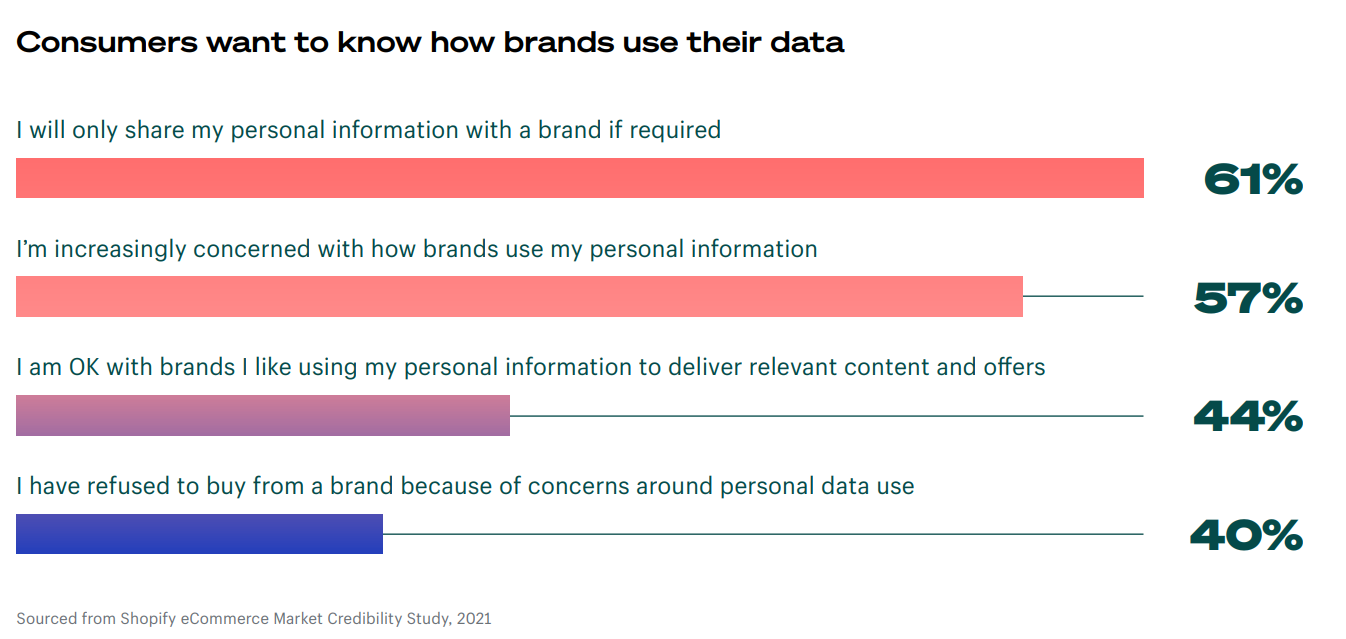
Source
Retailers are paying attention, with 42% of brands planning to offer customers personalized product recommendations using:
- Quizzes
- Custom mobile apps
- Behavioral data from first- and third-party data
Another 44% have plans to be transparent about customer information usage. Grocers can and should do the same. With stor.ai, grocers have a white label e-commerce app equipped with AI and personalization features. It learns the customer’s shopping habits and makes personalized recommendations to increase average order values (AOV).
Plus, it integrates with your email platforms, POS systems, and in-store inventory systems. This way, grocers have an end-to-end solution for picking, fulfillment, inventory management, and relationship building.
Next, let’s review what grocers can do to build a personalized omnichannel experience in 2022.
How grocers can build omnichannel personalization
Consumers are shopping online more often than before. Yet, many still desire in-store shopping experiences. So having an omnichannel approach is non-negotiable in 2022.
Here are several ways grocers can build relationships and personalized experiences that foster a loyal customer base.
1. Build a brand community using live events (online and offline)
We’re in the age where retailers are tossing out the corporate-customer relationship for
“tribes.” They’re creating a community that establishes long-term relationships with buyers.
You can do this online using social media, but don’t forget about local. Consider hosting community events around causes your customers care about.
Do this regularly and you’ll earn a name for your grocery store as more than just a “seller.”
Promote these events online and even record them to share live and afterward. This creates cross-channel participation, conversations, and interest.
Monitor the comments and engage in discussions to humanize your brand.
An excellent example of this is the Hispanic grocery chain, Northgate Gonzalez Market. It launched a bilingual multimedia platform called Stay-at-Home Solutions, which shares recipes, activities, and DIY ideas for families. This was timely, given many families were on lockdown and stay-at-home restrictions.
Jungle Jim’s International Market also hosted Facebook Live events with discussions, Q&As, and behind-the-scenes access. They also use the platform to promote upcoming local events:
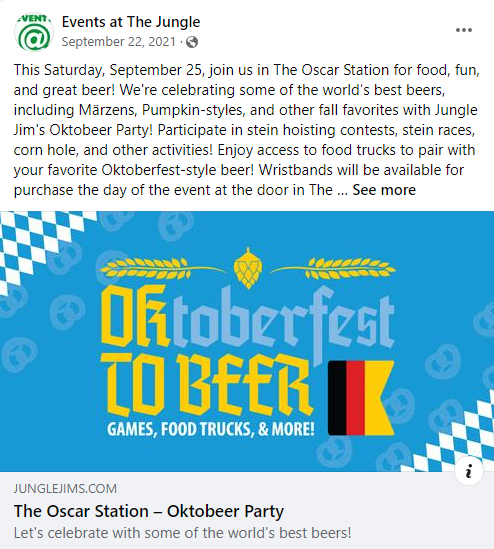
Source
How does this tie back to your personalization strategy? Collect personal data from attendees, such as names and emails. Then use that to create a special email campaign to notify them of upcoming events and share deals on products they like (based on other data you gather from other touchpoints).
Don’t forget to promote events to your events to get them engaged with your brand outside of shopping.
2. Use social commerce to grow your community (and sales)
Not all events have to be in-person. Host live webinars on social media to showcase new products you’re introducing to your shelves and the brands behind them. Consider focusing on themes, like new minority-owned or vegan brands.
Invite customers based on their interest in certain products.
Another option—bring on a foodie influencer for Halloween to make recipes live. Then make all the products revealed on the live show are purchasable via the platform.
Both Facebook and Instagram offer this feature.
It’s an area where many grocers fall behind, especially in the retail space. It’s a highly-profitable strategy that drives $36.6 billion in the U.S. (and $351.6 billion in China).
So there’s a lot of catching up to do in America. Thankfully, experts predict social commerce will nearly triple by 2025. Plus, live stream selling app installs increased by 61% globally, making it a great time for grocers to leap into live commerce.
When you do, add live chat to make it more sociable and easier to connect with customer service. Have personnel monitor the chat to answer questions. Also, anticipate inventory levels based on how many people register for the event, so you don’t run out.
How does this tie into your personalization strategy? Gather emails from attendees and create a segment for them. Those who purchase should have a separate segment based on the items they purchased from each event. Use this data to make personalized recommendations and invite them to other channels.
3. Create unique in-store experiences
Although more people are shopping online, many still crave in-person experiences. And most want more than a typical store visit—they’re investing in experiential retail. How to accommodate? Use stor.ai to enhance in-store shopping.
For example, if an item is out-of-stock, add QR codes to the shelf customers can scan to make the purchase online. The app can also make recommendations based on their shopping list, including substitution options.
Smart shopping carts are another technology grocers can use for this purpose. This device makes recommendations based on what’s in their cart (to increase AOV). Plus, customers can make purchases at the cart, speeding up checkouts.
According to Caper, smart shopping carts increase AOV by 18%. Consider using a phone-based solution to tie your customers’ data with your grocery e-commerce platform. This way, you collect more data to personalize their future shopping experiences.
Another way to enhance the in-store experience is to offer shopping appointments. Your staff can use a grocery e-commerce platform that connects with your mobile POS system to assist shoppers and make personalized recommendations. Keep this manageable by offering limited slots on specific days/hours.
With increased demand and competition in the grocery space, it’s critical to offer unique in-store experiences to stand apart.
“Retail competition has shifted to the individual customer,” says Gary Hawkins, founder and CEO of the Center for Advancing Retail & Technology (CART), “and knowing who your customers are along with their purchases and other information is no longer optional.”
Now, the question is, would anyone really use this service? Apparently, 34% of consumers say they’re likely to engage with appointment shopping in 2022.
4. Use email and SMS marketing to grow relationships
You’re connecting with customers via in-person and online events. Now, it’s time to connect in their inboxes. Email and SMS are powerful channels for one reason: they’re owned by you.
You get direct access to your customers (until they unsubscribe), and if you have a personalization strategy, you’ll find opens and conversions are easier to come by.
In the food and beverage industry, email open rates are 18.5% with a 2% click-through rate (clicks to your website). The average CTR across industries is 2.3%, so this isn’t bad at all.
With an email list, you can personalize your messaging based on first- and third-party data gathered from your e-commerce app, in-store purchases, browsing history, and direct communications.
Email is an excellent channel to communicate:
- Relevant product recommendations
- Reminders to reorder a product that may be running low
- Discounts on products they purchased in the past
- Shipping and delivery notifications
- Sitewide sales
- Nudges to return to their cart to complete a purchase
For example, grocers use stor.ai to send customers emails with personalized recommendations:

While email offers a direct connection to consumers, there’s nothing like SMS marketing. In 2016, text messages from brands had a 98% open rate. Even if this is 50% lower today, it’s still an amazing, yet underused channel by retailers.
With more shoppers being “mobile-first,” it’s a no-brainer why this works so well.
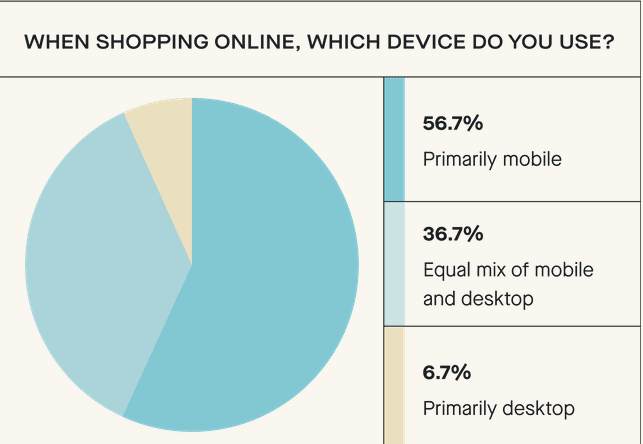
Source
Especially with consumers willing to sign up to receive texts from brands.

Source
In fact, over the past year, we witnessed a rise in consumers doing just that.
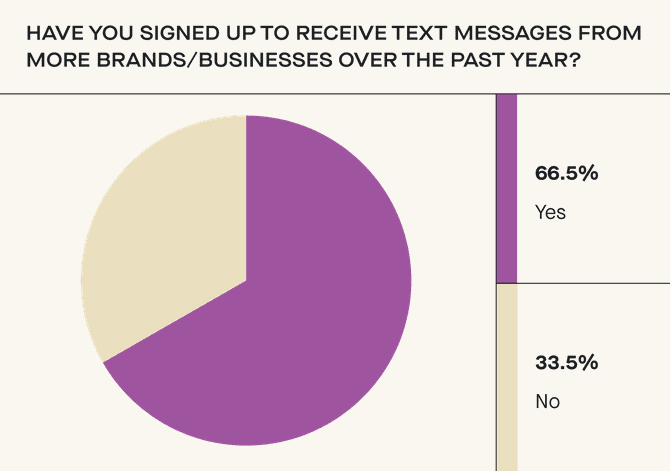
Source
How do you use SMS marketing successfully as a grocer? Send open-friendly text messages like:
- Shipping and delivery notifications
- Personal code to buy a favorite product
- Timely offers for seasonal products (e.g., holiday dinners and treats)
- Survey and review requests in exchange for a discount or freebie
- Gift card for referring a friend
- Reminders to redeem codes
Thrive Market does an excellent job with its SMS marketing. It creates shopping list ideas to drive customers back:
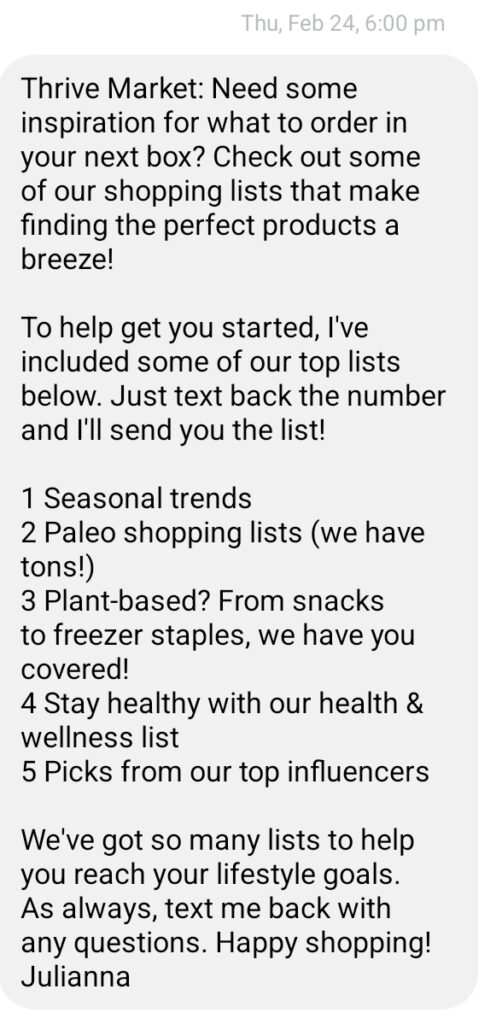
The key: keep emails and SMS messages relevant and occasional. Send too many and you risk unsubscribes. Also, note that SMS and email are two-way communication tools. Invite customers to hit reply to ask questions and send feedback.
5. Connect the in-store and online shopping experience
More customers are shopping in person, then purchasing online and vice versa. This makes it vital for grocers to make it easy for customers to do both interchangeably.
With stor.ai, your customers can use the app to find products and create shopping lists, and then go in-store to make the purchase. While there, if something’s out of stock, they can search for it on the app and purchase it from their mobile device.
The app will also make substitution recommendations using AI technology that analyze the customers’ search and purchase habits. For example, if they shop vegan categories, then recommendations will only consist of vegan products.
Here’s how stor.ai helps customers shop by showing product recommendations based on past purchases:
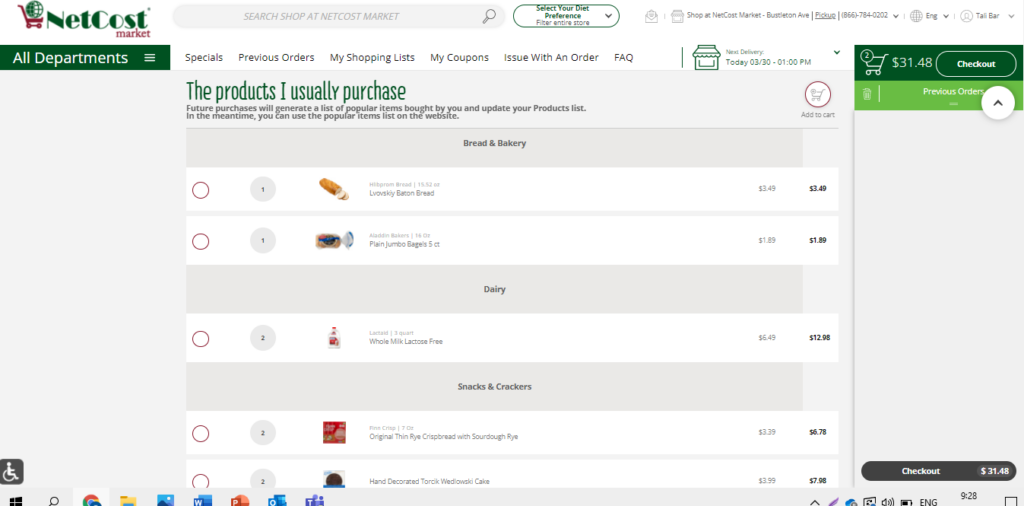
Technology like this also makes it easier for those who prefer BOPIS (buy online, pickup in-store). Grocers use stor.ai to enable customers to place orders via the app. Then their employees use the app to pick and fulfill the order for curbside pickup.
Roughly 50% of adults use BOPIS and their AOV is 67% higher than shopping in-store.
To connect in-store and online purchases, have your cashiers check customers out online, or email the customer a checkout link. Grocers like Publix use customer phone numbers to associate in-store sales with e-commerce grocery platforms.
Don’t just personalize, be personable
Personalization isn’t just about aligning offers to customers’ preferences. It’s about becoming a personable brand consumers want to follow and commune with. Today’s shoppers choose to buy from brands they adore, so show your human side every chance you get.
Show up on social media. Send conversational messaging. Ask for feedback. Most of all, listen to your customers and adapt your strategy based on their feedback.
You’ll find this is all easier to accomplish using the right technology. Grocers that use stor.ai have the tools needed to develop personalized experiences both online and in-store.
Our end-to-end picking and fulfillment solution makes it easy to get the right products into the hands of your customers. Want to see how it works? Book a demo with us today.
